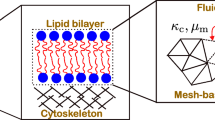Abstract
Construction of lipid membrane and membrane protein systems for molecular dynamics simulations can be a challenging process. In addition, there are few available tools to extend existing studies by repeating simulations using other force fields and lipid compositions. To facilitate this, we introduce Lipid Converter, a modular Python framework for exchanging force fields and lipid composition in coordinate files obtained from simulations. Force fields and lipids are specified by simple text files, making it easy to introduce support for additional force fields and lipids. The converter produces simulation input files that can be used for structural relaxation of the new membranes.

Similar content being viewed by others
References
Berger O, Edholm O, Jähnig F (1997) Molecular dynamics simulations of a fluid bilayer of dipalmitoylphosphatidylcholine at full hydration, constant pressure, and constant temperature. Biophys J 72:2002–2013
Bussi G et al (2007) Canonical sampling through velocity rescaling. J Chem Phys 126:014101
Chiu S-W, Pandit SA, Scott HL, Jakobsson E (2009) An improved united atom force field for simulation of mixed lipid bilayers. J Phys Chem B113:2748–2763
da Silva, A. & Vranken, W. F. BMC Research Notes | Full text | ACPYPE - AnteChamber PYthon Parser interfacE. BMC Res notes (2012)
Darden T, York D, Pedersen L (1993) Particle mesh Ewald: an N·log(N) method for Ewald sums in large systems. J. Chem. Phys. 98:10089–10092
Hess B, Hess B (2008) P-LINCS: a parallel linear constraint solver for molecular simulation. J Chem Theory Comput 4:116–122
Jämbeck JPM, Lyubartsev AP (2012) Derivation and systematic validation of a refined all-atom force field for phosphatidylcholine lipids. J Phys Chem B116:3164–3179
Jensen MO et al (2012) Mechanism of voltage gating in potassium channels. Science 336:229–233
Jo S, Kim T, Iyer VG, Im W (2008) CHARMM-GUI: a web-based graphical user interface for CHARMM. J Comput Chem 29:1859–1865
Klauda JB et al (2010) Update of the CHARMM all-atom additive force field for lipids: validation on six lipid types. J Phys Chem B114:7830–7843
Kukol A (2009) Lipid models for united-atom molecular dynamics simulations of proteins. J Chem Theory Comput 5:615–626
Kucerka N et al (2005) Structure of fully hydrated fluid phase DMPC and DLPC lipid bilayers using X-ray scattering from oriented multilamellar arrays and from unilamellar vesicles. Biophys J 88:12
Malde AK et al (2011) An automated force field topology builder (ATB) and repository: version 1.0. J Chem Theory Comput 7:4026–4037
Michaud-Agrawal N, Denning EJ, Woolf TB, Beckstein O (2011) MDAnalysis: a toolkit for the analysis of molecular dynamics simulations. J Comput Chem 32:2319–2327
Oloo EO, Kandt C, O’Mara ML, Tieleman DP (2006) Computer simulations of ABC transporter components. Biochem Cell Biol 84:900–911
Pabst G, Rappolt M, Amenitsch H, Laggner P (2000) Structural information from multilamellar liposomes at full hydration: full q-range fitting with high quality x-ray data. Phys Rev E Stat Phys Plasmas Fluids Relat Interdiscip Topics 62:4000–4009
Parrinello M (1981) Polymorphic transitions in single crystals: a new molecular dynamics method. J Appl Phys 52:7182–7190
Poger D, Van Gunsteren WF, Mark AE (2010) A new force field for simulating phosphatidylcholine bilayers. J Comput Chem 31:1117–1125
Pronk S. et al. (2013) GROMACS 4.5: A high-throughput and highly parallel open source molecular simulation toolkit. Bioinformatics. doi:10.1093/bioinformatics/btt055
Roux B, Karplus M (1994) Molecular dynamics simulations of the gramicidin channel. Annu Rev Biophys Biomol Struct. 23:731–761
Skjevik ÅA, Madej BD, Walker RC, Teigen K (2012) LIPID11: a modular framework for lipid simulations using amber. J Phys Chem B116:11124–11136
Ulmschneider JP, Ulmschneider MB (2009) United Atom Lipid Parameters for Combination with the Optimized Potentials for Liquid Simulations All-Atom Force Field—Journal of Chemical Theory and Computation (ACS Publications). J Chem Theory
Vanommeslaeghe K, MacKerell AD Jr (2012) Automation of the CHARMM general force field (CGenFF) I: bond perception and atom typing. J Chem Inf Model 52:3144–3154
Acknowledgments
We thank Matt Eckler for beta-testing Lipid Converter.
Conflict of interest
None declared.
Funding
This work was supported by an European Union fellowship (Marie Curie) PIOF-GA-2010-275548 to PL and NIH Grant RO1GM098304 to PK.
Author information
Authors and Affiliations
Corresponding author
Rights and permissions
About this article
Cite this article
Larsson, P., Kasson, P.M. Lipid Converter, A Framework for Lipid Manipulations in Molecular Dynamics Simulations. J Membrane Biol 247, 1137–1140 (2014). https://doi.org/10.1007/s00232-014-9705-5
Received:
Accepted:
Published:
Issue Date:
DOI: https://doi.org/10.1007/s00232-014-9705-5




